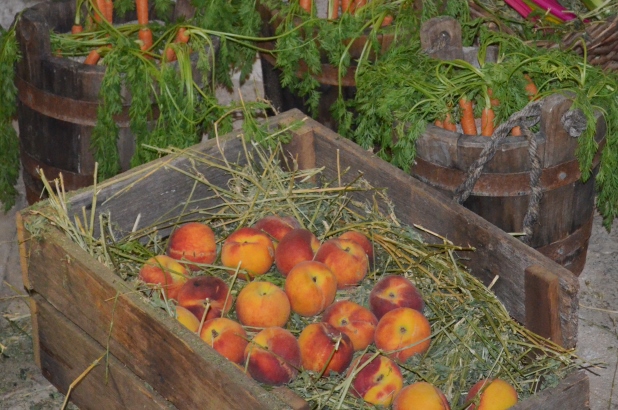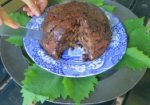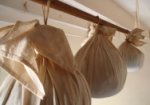December is upon us, and it’s time to ready ourselves for Christmas and all its festivities. My Christmas plum puddings are on the stove as I write, the fruit mince is made and at the ready for ‘pies on call’ or Christmas ‘cassata’ if the big day is too hot to have the oven on.
The joy of edible gifts
In an age when so many of us simply have too much ‘stuff’ there is no better offering towards a party, a kris-kringle or to celebrate a friendship than an edible gift. With peaches in abundance, and at their best right now, Jacky Dalton, guide and resident foodie at Elizabeth Farm and Rouse Hill House & Farm, is guest blogger this week, sharing her beautiful peach jam recipe just in time to be bottled and decorated for special friends, neighbours, teachers or workmates, or indeed, to indulge in at home over the festive break.
If you don’t have time to cook such delicacies yourself, don’t despair – our friends at Real Food Projects are holding their first ever Artisan Food Christmas gift market at Hyde Park barracks on Wednesday December 18. And for serious foodies out there whose pantries are always groaning, delight them with a unique experiential gift from our 2014 Eat your history FOOD programs in our summer calendar.
Preserve your reserves
Jacky Dalton, famous for her Regency-style fare, cooked up a storm for a very special Above, below and around open-day, held recently at Elizabeth Farm.
Nothing shows more, perhaps, the difference between a tidy thrifty housewife and a lady to whom these desirable epithets may not honestly be applied, than the appearance of their respective store – closets.
Mrs Beeton’s Book on Household Management 1861.
The ‘tidy thrifty housewife’
In the early days of the Colony, as in England, preserving abundant produce was a necessary task to ensure the continuity of ingredients throughout the year and to minimise the waste of precious food. It also illustrated the planning and management skills of the lady of the household.
In the early 1800’s, dining a la francaise meant that each course could consist of up to 14 different dishes, therefore the “tidy thrifty housewife” needed to be able to draw from a large repertoire and an even larger variety of ingredients. To serve this purpose, fresh produce had to be hung, churned, smoked, distilled, salted, pickled, potted, dried and “jammed”.
The cellar store
At a recent open day, Above, below and around at Elizabeth Farm, the cellar was brought to life with a selection of preserved goods that reflected the variety of fresh ingredients that were available to the Macarthurs 200 years ago. Visitors enjoyed sample tastings of a number of pickles including an Indian pickle (piccalilli) and pickled cabbage that appeared in every cookery book from the 1700s.
Elizabeth Macarthur wrote to a friend in England about the abundance of fruit and vegetables that could be grown in this unfamiliar climate, to the point that their pigs were fed with the left over melons and peaches. This year we were fortunate to receive 20 kilograms of peaches from a producer close to Rouse Hill House and Farm, and so instead of feeding the pigs as the Macarthurs might have done, I decided to make peach jam. To recreate the tastes of 19th century cooks, I chose an 1845 recipe from Eliza Acton; but be warned, the English liked their sugar so the jam is quite sweet. I also made a batch with a slight twist that was not a traditional component of English jam making, but more a reflection of the aromatics favoured by the wealthy in Regency England, and of course, in the Colony.
Tips for jam making, bottling and sterilising can also be found on this blog.
Fragrant peach jam
Ingredients
- 2kg peaches (halved and stoned, then each half cut into quarters)
- 1 teaspoon cardamom seeds, ground (taken from 8 cardamom pods)
- 1kg sugar
- 1/2 cup lemon juice (strained)
- 3 tablespoons orange blossom water
Note
This recipe is based on Eliza Acton's 'Peach jam, or marmalade' from 1845, with spice and orange blossom water added to balance out the sweetness of the fruit and sugar. The flavour of the jam improves with age.
Directions
| In a large preserving pan or stockpot, slowly bring the peach slices and ground cardamom to the boil over very low heat. Cook for 45 minutes, stirring frequently to prevent the fruit from burning on the bottom of the pan. Once the fruit is soft and pulpy, remove the pan from the heat. At this stage the fruit can be rubbed through a sieve if you prefer a fine jam, or you can use a potato masher to smooth out the consistency. Meanwhile, preheat the oven to 120° C. Put the sugar in a shallow baking dish and warm in the oven for 15 minutes. Put clean glass jars on a baking tray and warm in the oven for at least 30 minutes. | |
| Add the warmed sugar to the cooked fruit, and place the pan back on the stove over a low heat. Gently stir the sugar through the fruit until it dissolves completely. Once the sugar has dissolved, bring the mixture to a gentle boil, stirring frequently. Remove any scum that forms on the top, and continue boiling gently for a few minutes. Add the lemon juice and boil for another 5 minutes. Test for gelling, or setting point. Continue to boil the mixture until it reaches setting point. Remove from heat and stir in the orange blossom water. | |
| Scald the jar lids in boiling water for five minutes and drain well. Carefully remove the jars from the oven, and allow to cool for five minutes. Using a wide-necked funnel or small-spouted milk jug, fill the jars with the jam and seal while still hot, taking care not to burn your hands in the process – the jars will be very hot! Once the jam has cooled, label and date the jars. The jam will keep, unopened, for up to 12 months. Refrigerate after opening and use within three months. | |
| Cook's tip: for an added flourish, insert a couple of whole cardamom pods into the jam as you fill the jars, so that they sit just below the surface. It adds to the mystique of this aromatic jam. | |


 Print recipe
Print recipe

